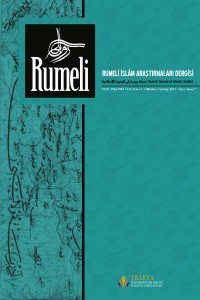XIX-XX Yüzyılına Ait Osmanlı Deftelerıne Göre Gjilan (Gilan) Kazasının Demografık Yapısı
Osmanlı’ya ait demografik bilgiler dönemin kaynaklarında yer almaktadır. Bu konuda XV-XV. yüzyıllarında tutulan tahrir defterleri başta olmak üzere XVII. yüzyılından itibaren tutulmaya başlanan avarız defterleri de demografik bilgiler hususunda önemli bir fon oluşturmaktadır. XIX. yüzyılın ilk yarısından itibaren nüfus defterleri olarak bilinen Osmanlı devletinde sancak, kaza, kasaba birimlerini içeren defterlerde nüfusun en detaylı bilgilerini ihtiva etmektedirler.Bu çalışmada Gjilan (Gilan) kasabasına ait 1832 nüfus ve 1845 senesine ait temettuat defterlerinden faydalanılarak Gilan kasabası merkezindeki mahalleler ve nüfus verileri, 1901 senesine ait Bekçi defterinden ise Gilan’a bağlı 191 köyünün nüfus bilgisi tabel şeklinde verilmiştir.Bu verilere göre 1901 senesinde Gilan kasabasının nüfusu 35.131’i Müslüman, 19.999’u Gayrimüslim olmak üzere toplam 55.130 olduğu geçmektedir. Bu veriler yüzdelik olarak % 63.72 Müslüman, %36.28 Gayrimüslim şeklindedir. Ayrıca 2011 senesinde Kosova devleti tarafından yapılan genel sayımının sonuçlarına göre sadece Sırp-Ortodoks nüfusundan oluşan Aşağı Budrik, Parteş, Zebinç, Pasjan (Pasyan), Tirinç gibi köylerde, 1901 senesinde Müslüman ahalinin de yaşadığı görülmektedir.
Anahtar Kelimeler:
Kosova, Gilan/Gjilan, Nüfus, Müslüm, Gayrimüslim, Sırp
The Population of Kaza of Gjilan According to the Ottoman Registers of the XIX-XX Century
The most important sources for the study of the demography of the Ottoman Empire and the peoples that ëere under its rule are the Ottoman documentary funds, among them the oldest registers belong to the XV- XVI century, ëhich are called “Tahrir Defterleri”, afterëards the extraordinary taxes (vergies) called "Avarez defterleri", and the overall ottoman registers of the population of the XIX century and the early XX century.In this paper we have dealt with the brief history of Ottoman registers over the centuries, the administrative historical of Gjilan until the XIX century, and the data on the population of Gjilan and the villages during the XIX century and beginning of the XIX century, where we have also translated the appointment defters of the bekçi (guards) in the villages of Gjilan, which provides detailed information on the population of villages in Gjilan during the year 1901.The data of registers of the years 1832 and 1845, as firsthand sources for researchers that deal with issue in hand, present new data on the population of Gjilan neighborhoods. While the defter of the Bekçi (guard) of 1901, presents statistical information on the population of the villages and the territorial extension of the Kaza of Gjilan. This defter contains important information on the names of the villages and the names of the guards (Bekçi) too. Furthermore it demonstrates the coexistence of Muslim and non-Muslim residents in the same villages. From 191 villages of the Kaza of Gjilan 100 of them were inhabited only by residents of the Islamic faith (müslüman), 16 non-Islamic (gayr-i müslüman) and 175 villages were mixed. At the same time these data also highlight the demographic changes on ethnic grounds that occurred after 1912, respectively, after the Ottoman Empire withdrew from these regions. This is seen in the villages of Budrika e Poshtme (Lower Budrika), Partesh, Zebince, Pasjan, Tirince, etc., which according to the 2011 Census of the Republic of Kosovo, these villages are inhabited only by residents of the Serbian Orthodox community. However, as we can see in the defter of Bekçi (guard), that we have translated into Albanian language, in 1901 these villages were also inhabited by Albanian residents of Islamic religion, which does not exclude the possibility of Albanian residents of Orthodox rite being registered as non-Muslim.
Keywords:
Ottoman Gjilan, Population, Bekçi, Non-Muslim, Serb, Kosovo,
___
- Mübahat S. Kütükoğlu, “1830 Nüfus Sayımına Göre Menteşe Sancağında Hane Nüfusu”, Osmanlı Araştırmaları XXIII (2003): 75- 76 K. Karpat, ibid. 19. Mahir Aydın, “Sultan II. Mahmud Döneminde Yapılan Nüfus Tahrirleri”, Sultan II. Mahmud ve Reformları Semineri 28-30 Haziran 1989, İstanbul Üniversitesi Edebiyat Fakültesi (Istanbul: 1990), 84-86. Kemal Karpat, Popullsia, ibid. Aliriza Selmani, Gjilani Qender e Anamoraves,(Gjilan: 2015), 49. Ibid. Hammer, Büyük Osmanlı Tarihi, (İstanbul: 1992), 211. Halil Inalcık, Günsel Renda, Qytetërimi Osman 1, (Tiranë:2018), 86. Ruhi Tarihi, 451. Iljaz Rexha, Venbanimet dhe Popullsia Albane e Kosovës sipas Defterëve Osmanë të shekullit XV, (Prishtinë: 2016), 160.
- ISSN: 2564-7903
- Yayın Aralığı: Yılda 2 Sayı
- Başlangıç: 2018
- Yayıncı: Trakya Üniversitesi
Sayıdaki Diğer Makaleler
Prizren Mutasarrıfı Mahmud Paşa’nın Vakıfları
Tercüme-i Sıhâh-i Cevherî’den (Vankulu Lugatı) Tarama Sözlüğü’ne Katkılar
Medreseden Darülfünûna Türkiye’de Yüksek Din Eğitimi
XIX-XX Yüzyılına Ait Osmanlı Deftelerıne Göre Gjilan (Gilan) Kazasının Demografık Yapısı
İçtımâî Tefsir Geleneği Açısından Abidin Paşa’nın Tefsirci Kimliği
Kadim Yollar Bağlamında Osmanlı Balkan Fetihlerinin Stratejik Unsurları: Üsküp’ün Fethi Örneği
“İslam’da Bireyselleşme”nin Teorisini Yazmak ne Kadar Mümkün?
Günümüz Kalkandelen Şehrinde Osmanlı İzleri
